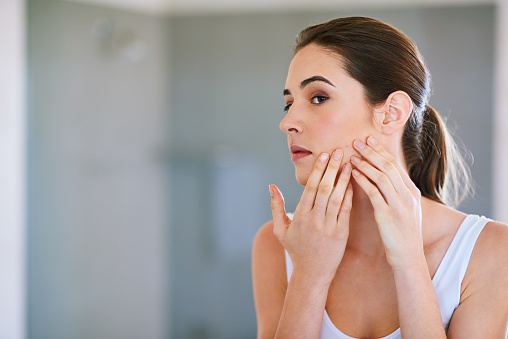
Acne is a skin condition affecting an estimated 650 million people worldwide, according to NICE. In 1982 Roche Pharmaceuticals found what would be considered the miracle cure to the condition, derived from a popular skincare substance known as retinoid.
This ‘miracle cure’ is called Isotretinoin, or Roaccutane, as its more commonly recognised. Roaccutane has been described as a controversial form of acne medication by many dermatologists and medical professionals across the world as it has a range of reported side effects.
The HSE reported side effects range from dry lips and skin, nosebleeds and headaches to more serious side effects like liver toxicity or kidney disease. The most publicised effects of Roaccutane are the correlation between patients on Roaccutane and depression or suicides.
Dermatologist will monitor a patients mood and behaviour while taking Roaccutane. There are also warnings of this link to suicide and depression by Roche Pharmaceutical ans the HSE. This link has possibly caused the greatest divide in opinion in the medical community on whether the drugs benefits outweighs the associated risks.
Roaccutane poses an extremely high risk of severe birth defects during the course of treatment and for a number of months post treatment, with defects ranging from skull abnormalities to cardiovascular defects and in some cases death of an unborn child, according to Roche Pharmaceuticals.
It’s not prescribed to pregnant women, and women who could become pregnant are given two forms of birth control and monthly pregnancy tests are carried out by the dermatologist.
Roaccutane was taken off the market in 2009 due to mounting law suits against the Pharmaceutical company Roche, however Isotretinoin is still available under generic names.
Loren Simms, a 17-year-old student and influencer from England started to develop acne when she was nine-years-old. When she began her Roaccutane journey, she set up her Instagram page to spread awareness about the medication, to document her journey and to support her followers along their journey also .
Her following grew rapidly over a short period of time and here page now documents other areas of her life.
“For a long time I thought my acne was hormonal. It was on and off for six years. It would be really intense and then go away and almost be clear. I went to the doctors and I tried creams, antibiotics and the pill for years,” Simms said.
Developing acne caused Simms to feel “really down”, and she links her experience of depression, anxiety and low self-esteem to the intense outbreaks of the medical condition.
“I remember every time I went to the doctor I’d get a new cream or pill to see if it would work but it was always leading to the inevitable which was to go on Roaccutane so I definitely think there should be more direct routes to get on it. There should be more support to getting to the route cause.”
Simms thinks that the contraceptive pill, which is often used for treating acne, is “very pushed”:
“I remember within a few minutes during my first appointment I had to do a pregnancy test, then [the doctor] went straight into talking about contraception and the side effects if I got pregnant.
“I’m not sexually active so I did get away with not being on [the pill], but from talking to girls on my Instagram, some have even pleaded not be put on contraception, but they were refused Roaccutane without being on it.”
Since finishing her Roaccutane treatment, Simms says she still experiences anxiety and depression, feelings she first battled with when her acne started to develop. She added that there is a need for more support when patients finish their Roaccutane treatment, particularly for scarring: “They forget scarring can impact people just as much as acne can. I want to treat my scars because it’s the mental reminder of what I’ve been through.”
For Tara Catlett, an 18-year-old journalism student at DCU, her acne began to develop when she was 14-years-old.
“I went to the doctor and I was given cream and then I was given antibiotics, they worked it went away for a while. My acne came back when I was 15,and I was prescribed the pill to clear it. I came off the pill after a while, and then [started] Roaccutane. I’m just about to finish month three,” Cartlett said.
Reflecting on her prescribed use of the contraceptive pill to treat her acne, Catlett feels she could have been told more information about the “physical and mental” effects.
Given that Roaccutane is generally only prescribed once women are on a form of contraceptive, she added that the conversation centred around the use of the pill as a means to access Roaccutane.
Unlike Simms and Catlett, Josh Casey, a 19-year-old Computer Science student at DCU, actively sought out Roaccutane to treat his acne:
“Before Roaccutane I tried different creams and medications like antibiotics. I had to specifically ask my GP to be put on it I was on Roaccutane for eight months. I did plenty of research online about side effects.
“I had a mental health sheet to fill out every month. the questions were so different, ranging from are you happy to have you thought about suicide.”
Evidently, Roaccutane’s side effects can be varied and severe. However, there is no denying that in most cases Roaccutane can do what no other acne medication on the market can do.
It has a high success rate and can in most cases clear sever forms of acne. It has given many people the confidence and relief from both the physical and emotional strain of the condition.
While this comes at a cost, there is still hope that future acne medication can reduce the side effects and increase the efficacy.
Meghan O’Halloran
Image credit: Unsplash
